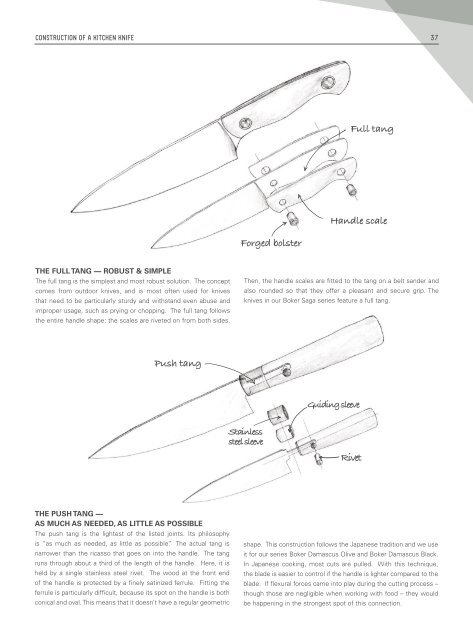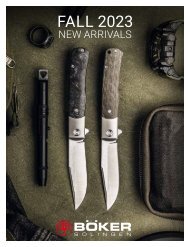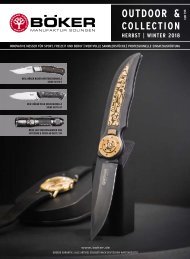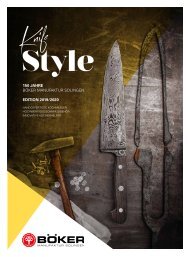Boker Knifestyle | EN Edition 2018 / 2019
You also want an ePaper? Increase the reach of your titles
YUMPU automatically turns print PDFs into web optimized ePapers that Google loves.
CONSTRUCTION OF A KITCH<strong>EN</strong> KNIFE<br />
37<br />
Full tang<br />
Handle scale<br />
Forged bolster<br />
THE FULL TANG — ROBUST & SIMPLE<br />
The full tang is the simplest and most robust solution. The concept<br />
comes from outdoor knives, and is most often used for knives<br />
that need to be particularly sturdy and withstand even abuse and<br />
improper usage, such as prying or chopping. The full tang follows<br />
the entire handle shape; the scales are riveted on from both sides.<br />
Then, the handle scales are fitted to the tang on a belt sander and<br />
also rounded so that they offer a pleasant and secure grip. The<br />
knives in our <strong>Boker</strong> Saga series feature a full tang.<br />
Push tang<br />
Guiding sleeve<br />
Stainless<br />
steel sleeve<br />
Rivet<br />
THE PUSH TANG —<br />
AS MUCH AS NEEDED, AS LITTLE AS POSSIBLE<br />
The push tang is the lightest of the listed joints. Its philosophy<br />
is “as much as needed, as little as possible”. The actual tang is<br />
narrower than the ricasso that goes on into the handle. The tang<br />
runs through about a third of the length of the handle. Here, it is<br />
held by a single stainless steel rivet. The wood at the front end<br />
of the handle is protected by a finely satinized ferrule. Fitting the<br />
ferrule is particularly difficult, because its spot on the handle is both<br />
conical and oval. This means that it doesn’t have a regular geometric<br />
shape. This construction follows the Japanese tradition and we use<br />
it for our series <strong>Boker</strong> Damascus Olive and <strong>Boker</strong> Damascus Black.<br />
In Japanese cooking, most cuts are pulled. With this technique,<br />
the blade is easier to control if the handle is lighter compared to the<br />
blade. If flexural forces came into play during the cutting process –<br />
though those are negligible when working with food – they would<br />
be happening in the strongest spot of this connection.

















